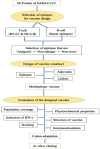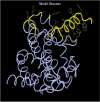Design of a multi-epitope-based vaccine targeting M-protein of SARS-CoV2: an immunoinformatics approach
- PMID: 33252008
- PMCID: PMC7754933
- DOI: 10.1080/07391102.2020.1850357
Design of a multi-epitope-based vaccine targeting M-protein of SARS-CoV2: an immunoinformatics approach
Abstract
In the present study, one of the targets present on the envelopes of coronaviruses, membrane glycoprotein (M) was chosen for the design of a multi-epitope vaccine by Immunoinformatics approach. The B-cell and T-cell epitopes used for the construction of vaccine were antigenic, nonallergic and nontoxic. An adjuvant, β-defensin and PADRE sequence were included at the N-terminal end of the vaccine. All the epitopes were joined by linkers for decreasing the junctional immunogenicity. Various physicochemical parameters of the vaccine were evaluated. Secondary and tertiary structures were predicted for the vaccine construct. The tertiary structure was further refined, and various parameters related to the refinement of the protein structure were validated by using different tools. Humoral immunity induced by B-cells relies upon the identification of antigenic determinants on the surface of the vaccine construct. In this regard, the vaccine construct was found to consist of several B-cell epitopes in its three-dimensional conformation. Molecular docking of the vaccine was carried out with TLR-3 receptor to study their binding and its strength. Further, protein-protein interactions in the docked complex were visualized using LigPlot+. Population coverage analysis had shown that the multi-epitope vaccine covers 94.06% of the global population. The vaccine construct was successfully cloned in silico into pET-28a (+). Immune simulation studies showed the induction of primary, secondary and tertiary immune responses marked by the increased levels of antibodies, INF-γ, IL-2, TGF-β, B- cells, CD4+ and CD8+ cells. Finally, the vaccine construct was able to elicit immune response as desired.Communicated by Ramaswamy H. Sarma.
Keywords: COVID-19; SARS-CoV2; immunoinformatics; membrane glycoprotein; multi-epitope vaccine.
Conflict of interest statement
No potential conflict of interest is reported by the authors.
Figures











References
-
- Alexander, J., del Guercio, M. F., Maewal, A., Qiao, l., Fikes, J., Chesnut, R. W., Paulson, J., Bundle, D. R., DeFrees, S., & Sette, A. (2000). Linear PADRE T helper epitope and carbohydrate B cell epitope conjugates induce specific high titer IgG antibody responses. Journal of Immunology, 164(3), 1625–1633. 10.4049/jimmunol.164.3.1625 - DOI - PubMed
-
- Ali, M., Pandey, R. K., Khatoon, N., Narula, A., Mishra, A., & Prajapati, V. K. (2017). Exploring dengue genome to construct a multi-epitope based subunit vaccine by utilizing immunoinformatics approach to battle against dengue infection. Scientific Reports, 7(1), 9232. 10.1038/s41598-017-09199-w - DOI - PMC - PubMed
Publication types
MeSH terms
Substances
LinkOut - more resources
Full Text Sources
Other Literature Sources
Medical
Research Materials
Miscellaneous
